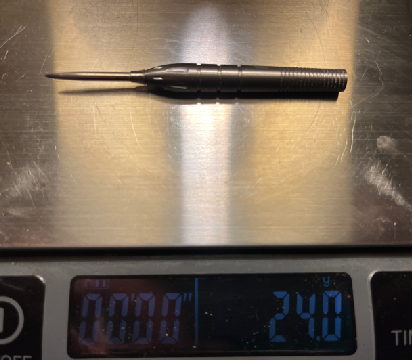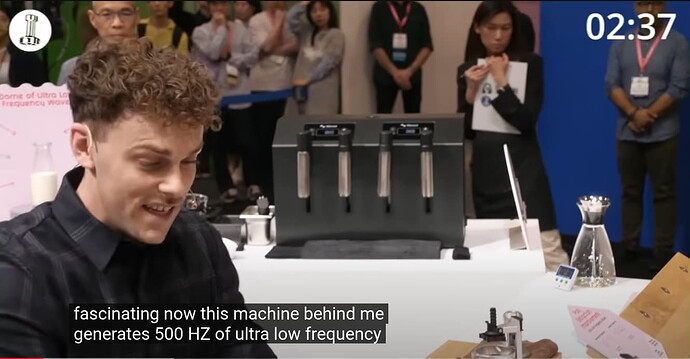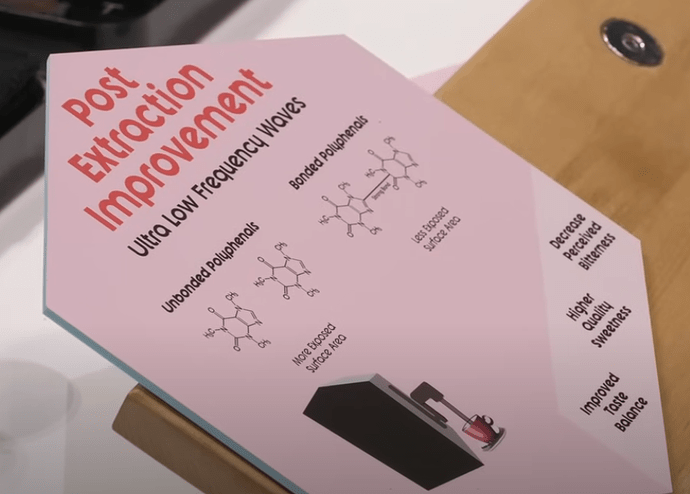I’ve been stirring my beans with a wet spoon before grinding as a cheapo version of WDT, I finally got a spray bottle, and while the wet spoon technique does help a lot, the spray bottle is WAY better. no static cling AT ALL anymore.
I’m curious to hear what y’all think of the tricolate. I bought into the hype and got one a long ways back but I gave up on it after just a few brews. They were all worse than anything I’ve had in years.
I’ve been really happy with my xBloom and haven’t messed with brewing anything manually in quite some time. I’ve had a lot of consistently good cups just using their pods and I’ve been happy with that. I haven’t had anything absolutely mind blowingly fruity though. I’m thinking about starting to experiment with my own beans and programming recipes. I might even buy the new version that has a few more bells and whistles.
Routine from a back-to-back WBC finalist. Emphasis mine.
Last year I focused on my espresso pre-extraction with the auto comb and the vibrating table. This year with a pursuit of constant improvement I thought what can I do next so I decided to focus on my post-extraction with a big goal in mind to enhance the taste experience.
We began collaborating and exploring the potential for post extraction espresso improvement and the results have been fascinating.
Now this machine behind me generates 500 HZ of ultra low frequency electromagnetic waves and by sending waves to the espresso we are energizing the water molecules essentially causing them to vibrate.
But why is this important? Well as you may know coffee is high in polyphenols like caffeine contributing to some of the bitterness in the coffee, but by sending waves to the espresso we’re encouraging these molecules to bond together.
Every coffee requires a different length of waves and today I found two seconds gave me the best taste experience really highlighting that blood orange in this course.
These events are like the World Series of Mall Kiosk Ion Bracelet Hucksters.
I have tried it and seemed pretty straight forward to brew a decent cup, despite me fucking it up. I can’t give it a serious review because it’s at my new house and I’ve only used it 4 times using my old Cuisinart burr grinder and without a scale. I have a pretty good eyeball/feel for <20g of ground beans, but the water + timings I’m just winging it and ends up alright.
How did I fuck it up? Well, you wet the filter, etc with hot water before putting in any beans and I put this over my cup so it would go through the filter and warm up the cup. Well, I was high and forgot to discard that plain water so my first 2 brews were very very weak. Then I realized what I did and it was pretty easy to make a basic cup.
hahaha jesus christ
I am tricolate-curious but haven’t tried it myself. it seems like a good idea on the surface, bypass is a variable, eliminating it if it can’t be controlled should be a good thing.
I’m not convinced that it can’t be controlled, though, most of the beans I brew in the v60 are pretty well behaved and don’t have wild drawdown variations if everything else is constant, which tells me whatever amount of bypass is happening is (generally) reproducible,
that said, I have definitely had some beans where the drawdown times swung pretty wildly, but I don’t know how much that would have been reduced if I had a zero-bypass brewer.
I haven’t tried the xbloom either but the more I see of it the more impressive it seems. My first impression was that it was a total gimmick but it seems like a really nice machine, particularly for people who want their high-end pour-over experience to be more along the lines of “I just want someone who knows what they’re doing to make the coffee” and less of “I want to drive myself insane with endless tinkering”
Theoretical advantage of no-bypass is that you can achieve the same yield using less coffee. I think Tricolate recommends going as high as 22:1. However, it seems like people are mostly not doing that, either because the results are bad or the brew takes 10 minutes. Instead I see a lot of people doing a traditional 16:1.
By the way, there’s still a common misconception that somehow the goal of no-bypass (and brewing in general) is to get HiGhEr aNd HiGhEr ExTrAcTiOnS into the 25%-30% range. I dunno where this came from but it’s the same people advising to grind as fine as possible (400-500 um range) and only use boiling water b/c that’s how you get the bigly extractions. Which is to say people who don’t know what they’re doing.
Btw @pvn have you considered going to a small 0.01g jeweler’s scale for dosing and running a second scale for pouring? I doubt there’s an affordable 0.1g scale on the market that won’t bounce / drift in 0.1g increments and that includes the Acaias.
Sidenote: I must have run hot on the MyWeigh because I’ve had it for several years now with no real issues. I’ve never run a calibration or tested it against a known quantity until recently when I bought a set of match-weighted darts to +/- 0.05g of 24g and they all read dead on the number.

eh, it was kind of annoying at first but I don’t think it really matters that much in the big picture so I can’t be bothered ![]()
I begrudgingly accept the Acaia for what it is: the Apple TV 4K of coffee scales. Costs way more than its competition but then you use the competition and realize it’s all junk. Then happily pay the ransom to end the torture and get the product that actually works. Not that Apple TV or Acaia are flawless–far from it–but I get it.
Look how coarse he’s grinding! Also left the Church of Boiling and now maxes out at 95 C. This is going to be really confusing to people who’ve been taking bad advice for years.
this is basically where I’ve settled for V60, most of the time I start a new bag around 8K on the Vario, and usually start at 16:1 at 205F (which is … roughly 95C?). Occasionally I have a bag that needs something wildly different (just finished a pink bourbon that I had to adjust down to like 5K before it came out OK) but 90% of them 8 or 9 does it.
Edit: Just skip to the next post and watch the video if you want to fade this text ocean.
Sounds about right. You should check out his recent video on grinders. Two key things we’ve talked about before: freezing the dose and slow feeding the grinder. I’ve been on Team Freeze since I first wrote about it here but didn’t have an explanation for it. This was from March 2020:
Lance thinks it probably protects against heat damage caused by the coffee regrinding itself when trapped between the prebreakers and finishing teeth. Slow feeding helps prevent this logjam of coffee which some grinders such as the Vario are more susceptible to by design. That design consists of no feed auger, vertical motor shaft orientation, and small burrs.
Slow feeding definitely shifts the distribution coarser and maybe more unimodal. Remember how the prevailing theory used to be that popcorning was awful and ruined your grind? People were filling up their hoppers with a bag of coffee to grind 15g then emptying haha. (I mean people were doing this every time they brewed coffee. Not tried it a few times as an experiment.)
Regarding freezing, I recall reading an older article (can’t remember source) that analyzed frozen doses and concluded that they grind finer and produce more fines. The inference that most “coffee community” NPCs seemed to make is that you should never grind a dose out of the freezer because zomg fines.
Having done both tricks many times, freezing has better returns in my experience. Not practical without doser vials like the ones Weber sells, so we should source an alternative. Slow feeding a Vario is a major pain in the ass because (1) takes forever and (2) popcorn show. Need a Niche Zero trapdoor feeder for that to be viable.
Wait that seemed way more condensed in my head than it looks typed it out. Should have just linked this:
Some instant coffee reviews from Portland (Maine)
-
Double Great Coffee: very nice neighborhood joint. opens early (6:30), Apple store aesthetic, no tipping allowed, great shot (very nice earthenware demitasse, served with spoon but no sparkling water), good baristas. location is not super convenient to city center but walkable (I was staying right across the street from city hall). B+
-
Bard Coffee: open at 7, great location, nice pastry selection, decent shot served with water/spoon on a nice wooden tray. B.
-
HiFi Donuts: good location, donuts are good, shot was drinkable (paper cups only), only real redeeming feature is they open at 6. C.
-
Proper cup: another nice neighborhood joint, wouldn’t have gone here normally but I rented a car on this trip since I was lighthouse spotting. Competent shot. Cute little demitasse, no spoon/water. B.
-
Coffee by Design: local chain that seems to be focused on roasting for wholesale, large space in a warehouse district, very chill vibe, above average shot. No spoon/water/saucer. B-.
-
Tandem Coffee. really wanted to try this place out, but the cafe was closed for repairs on Tuesday, and by the time I got to go back by Wednesday they were already closed.

-
Coffee ME Up (took me a minute to realize that ME is capitalized because it’s MAINE): great little neighborhood place, walkable from city center, probably the best chocolat au pain I’ve had in a long time, excellent shot, no spoon/sparkling. A-.
-
Arabica Coffee: good downtown location, decent shot, kinda weird space (the cafe is very long and skinny), B-.
Couple of restaurants:
Becky’s Diner: didn’t have the coffee but the lobster roll was perfect A+++++
CBG: kinda hipster vibe that I was very much into, food was excellent, best wedge salad I’ve had in a while, A++++++++
Marketplace Cafe (this was way north of town in the middle of nowhere): great little diner, had a very competent burger, haven’t seen Shit on a Shingle actually on a printed menu before A.
Dutch’s: great breakfast, salmon bagel was really good, hashbrowns here are absolutely don’t-miss, A++++++++
hahah yeah should have been “instant cafe reviews”
so you were there for just the one day then?
Time to reload and this is the part I hate. The market is flooded with unremarkable coffee at increasing prices and decreasing portions. How about $30 for 250 grams? Do I hear $60 for 100 grams? I basically never buy these for three reasons:
(1) Often it’s just mediocre coffee at a sucker price.
(2) That’s not enough coffee to dial in.
(3) You’re paying a small portion premium.
The only exceptions I’ll make are for truly elite coffee estates (Elida, Esmeralda, etc.) or COE scores which are rarely available. Even then, I’m never looking to buy 100g of coffee. Few places even offer them in larger quantities. Check Prodigal which is loaded up with COE winners but obviously he knows what he has and the price matches ($100+/lb). It’s getting to the point where I might have to consider nano roasting.
PS: By far the best value outcome is finding a great coffee from a non-premier estate that didn’t win any competitions or awards. The problem is that you’ll go through probably 20-25 coffees before you find one in my experience, which is why I think all roasters should offer sample packs with 1-2 doses.




